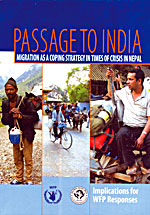 Passage To India Migration As a Coping Strategy in Times of Crisis in Nepal WFP and Nepal Development Research Institute, 2008 Available online at: www.wfp.org |
When Lil Bahadur Chhetri wrote the classic Nepali novel, Basain, in 1958 Nepal's population was only 8.5 million, and there was an exodus of Nepalis going to India in search of work.
Today the country's population is touching 30 million and hundreds of thousands of Nepalis still migrate to India for the same reasons as Basain's protagonists: lack of food and indebtedness. For centuries, out-migration has been the way Nepalis have coped with poverty, injustice and lack of opportunities back home. And when the war came in 1996, it was just another hardship that became a push factor.
Nearly 15 per cent of Nepal's population is now working abroad and this represents more than a quarter of the country's young adult male population. The 1.5 million Nepali workers in the Gulf, Malaysia and East Asia get all the attention in the media because of the remittances they send home but there are an estimated two million Nepali migrant workers in India at any given time. The money they send home represents half of Nepal's remittances but never seems to be counted in official statistics.
The UN's World Food Programme (WFP) and the Nepal Development Research Institute have tried to set this right with a new report, Passage to India: Migration As a Coping Strategy in Times of Crisis in Nepal. The reason WFP is involved is because the reason for migration to India has historically been the lack of food, especially in western Nepal. The average rainfed farms grow enough food to feed families for only 150 days in a year. Migration is the only way to survive.
Nepal's chronic food shortage has increased in recent years. In 2008, the food deficit got worse and was compounded by the global rise in the price of grain. The food situation for nearly four million Nepalis is very precarious and if it continues there could be another dramatic spurt in migration to India in the coming year.
The report has some remarkable findings. For example, nearly all the respondents surveyed in western Nepal said they would not migrate if they had enough food or if they could earn just Rs 1,200 per month in Nepal. This isn't asking for much, and it is a mystery why successive governments have failed to provide even this bare minimum.
WFP itself says its food assistance has reduced seasonal migration to India considerably. India is the cheapest destination for work, even cheaper than travelling to other areas of Nepal. But the average annual remittances sent by workers from India is also the lowest,
Rs 9,800 a year, whereas the money from the gulf and Malaysia averages Rs 83,000 a year. Still because of the sheer numbers of Nepalis in India, the money they send back keeps subsistence farming families alive back home.
The book details patterns of migration, where workers come from and where they go in India and the route they take to get there. Most of them work as porters, followed by security guards, waiters and in construction. Of the money they save, their families spend most of it on clothes (27 per cent) education (22 per cent) food (19 per cent). Rupaidiya, Gaddachauki and Bhairawa are the most popular border crossings and the reason is that 60 per cent of Nepali workers in India come from western Nepal.
While migration by itself may not be a negative phenomenon, the fact that most migration is involuntary and caused by lack of jobs and opportunities at home points to deep-seated structural problems in Nepal's society and economy. Research has also shown that crop diversification and cooperatives to augment farmer income is the most effective way to reduce outmigration from rural Nepal.
Migration has also brought along a host of social problems that result from prolonged separation of family members. The reason HIV has reached crisis proportions in parts of western Nepal is that many workers come back with the infection from India. Six of the seven districts regarded as AIDS hotspots are in western Nepal. In one Dailekh village, 22 of 80 returning migrants were tested positive for HIV. In Achham, of 3,826 villagers tested, 403 were HIV positive, and 73 per cent of them were women.
With nearly half of Nepal's population less than 15 years of age, with unemployment and chronic food shortages, it is clear that even migration to India will not be enough of a safety valve in the future. Unless domestic job creation is stepped up and food security ensured, it is not difficult to foresee economic collapse with attendant political repercussions.
Kunda Dixit


